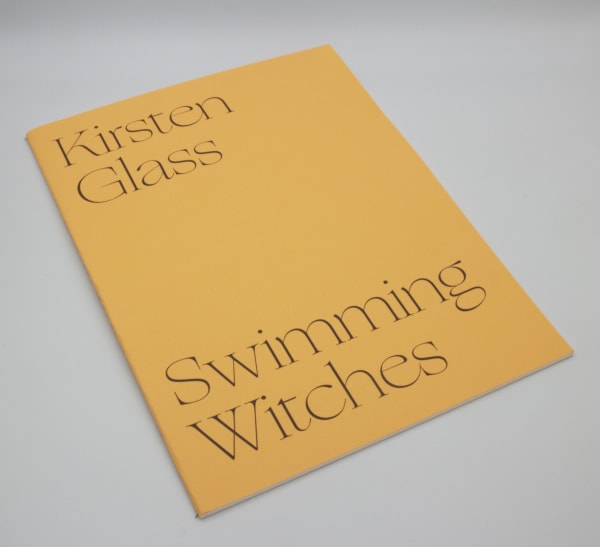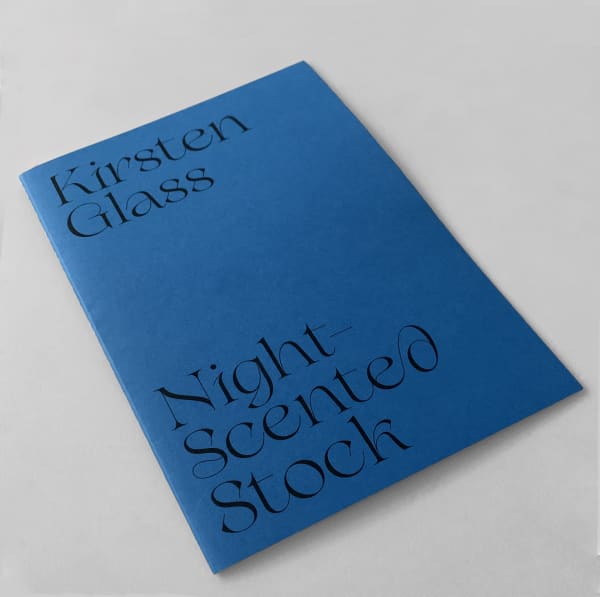Kirsten Glass
Kirsten Glass (born Belfast, 1975) was part of a new generation of artists who fed straight from college into London’s contemporary art scene in the late 1990s. By the time Glass graduated from her master’s at Goldsmiths in 2000, she had two solo shows in London and Los Angeles behind her. She went on to take part in a succession of high-profile group exhibitions, securing a strong following among the established art world and up-and-coming artists alike.
Glass became known for making group portraits of beautiful women with bright colours pulsating against lustrous black backgrounds; graphic bands of text running along the bottom referenced a song lyric or indicated a mood. With titles such as Voodoo Dolly and Stellar Skin, these large-scale, collage-based paintings were confident, atmospheric and fresh, embodying the exhilaration of queer and alternative club culture. Her models were cut out of magazines – overtly commodified, saturated with make-up and bleached by artificial lighting. Glass enhanced this further by fetishising them through the sensual activity of the painting process, incorporating brushwork that ranged from intricately rendered detail to hard, graphic text and opaque stencilled shapes, energised by seemingly reckless drips and swathes of thick impasto. She demonstrated how a slick commercial image could be dismantled and remade in a new context, simultaneously exploring the interplay of multiple painting styles. This early, youthful work saw Glass borrowing content from throwaway sources as readily as she would from art history, mixing high, low and alternative culture into an exciting, seductive cohesion. When these paintings were shown they had an undeniable presence, combined with a daring scale that dwarfed the viewer.
Throughout her career, Glass has continued to push the boundaries of what she can do with painting. In early 2012 she began a body of work that excluded the figure and employed abstract patterns and sacred geometry: the repetition of the ‘flower of life’ symbol provided an underlying structure and rhythm to paintings executed in a restricted palette of greys and sepias, hinting at more sombre interests. This work led to a solo show at HIX ART, London (2014), titled Persephone, Queen of the Underworld. Glass continued to use geometry as an under-netting for her paintings while gradually reintroducing stock images of animals and figures.
In Swimming Witches, her solo show at Karsten Schubert London in 2020, Glass presented a group of new paintings that cross-referenced each other through their colour palette and recurring motifs, linking to a central tabletop altar installation. These paintings were her most complex and layered to date, incorporating her interest in painting as a spiritual practice and her personal immersion in modern witchcraft. The notion of external energies being invoked through the painting process is prevalent throughout the series. The paintings resonate with rich, jewel-like colours – ochres, Prussian blue and Permanent Rose – sensually blended and juxtaposed with the finely scratched lines of a compass. Figures now are deliberately anonymous, their once provocative stares and poses replaced with a spectral presence, at times hardly visible (Kittens, 2017; Come Through, 2010) and at others overpainted and fossilised, or as if emerging from the background of the painting. Even when objects and characters are described clearly or represented as a bold graphic, the narrative itself is intentionally veiled. The rich black backdrop that Glass favours serves to hold in place an assembly of seemingly mismatched components within a made-up dream world of animal familiars, esoteric symbols, sigils, sewn marks, recognisable objects and abstract shapes.
Glass invites us to look at an enchanted world, to step into ritual and reconnect with folklore, animism and magic. She wants the viewer to find pleasure in her paintings and to experience them as fictive worlds with their own life force. For Glass, painting allows for a transmutation of ideas and emotions, finding connections between the material and the imaginary and always hinting at the unknown.
Kirsten Glass received a BA from Chelsea College of Art and Design, London, in 1996, and an MA from Goldsmiths College, London, in 2000. Her solo shows have included Youthinkyoufuckinslick[AS1] , Alfred Camp, London (1999); Ace Gallery, Los Angeles (1999); Habitat, London (2000); One in the Other, London (2001, 2004); Hales Gallery, London (2006); The Body in the Library, V22 Ashwin Street, London (2007); A Spritz of Absinthe, Xero, Kline & Coma, London (2012); Persephone, Queen of the Underworld, HIX ART, London (2015). Glass has also participated in numerous high-profile group exhibitions, including Death to the Fascist Insect that Preys on the Life of the People, Anthony d’Offay Gallery, London (2001); Beck’s Futures, ICA, London (2002); and Electric Dreams, Barbican Curve, London (2002). She has taught as a visiting artist at the Slade School of Fine Art, Goldsmiths College and Chelsea College of Arts and is an associate mentor for Turps Banana.
-
 Kirsten GlassFor Flora, 2020Oil paint, glitter and sand on canvas143 x 122 cm | 56 1/4 x 48 1/8 in
Kirsten GlassFor Flora, 2020Oil paint, glitter and sand on canvas143 x 122 cm | 56 1/4 x 48 1/8 in -
 Kirsten GlassGoing In, 2020Oil paint, acrylic, glitter, sand and embroidery thread on canvas162 x 130 cm | 63 3/4 x 51 1/8 in
Kirsten GlassGoing In, 2020Oil paint, acrylic, glitter, sand and embroidery thread on canvas162 x 130 cm | 63 3/4 x 51 1/8 in -
 Kirsten GlassPurple Chooser (Jupiter), 2020Oil paint, glitter and embroidery thread on canvas240 x 190 cm | 94 1/2 x 74 3/4 in
Kirsten GlassPurple Chooser (Jupiter), 2020Oil paint, glitter and embroidery thread on canvas240 x 190 cm | 94 1/2 x 74 3/4 in -
 Kirsten GlassVisitor, 2020Oil paint, glitter and sand on canvas162 x 130 cm | 63 3/4 x 51 1/8 in
Kirsten GlassVisitor, 2020Oil paint, glitter and sand on canvas162 x 130 cm | 63 3/4 x 51 1/8 in -
 Kirsten GlassBeltane, 2019–20Oil, acrylic, glitter and sand on canvas51 x 40.5 cm | 20 1/8 x 16 in
Kirsten GlassBeltane, 2019–20Oil, acrylic, glitter and sand on canvas51 x 40.5 cm | 20 1/8 x 16 in -
 Kirsten GlassBody, 2019–20Acrylic on canvas51 x 40.5 cm | 20 1/8 x 16 in
Kirsten GlassBody, 2019–20Acrylic on canvas51 x 40.5 cm | 20 1/8 x 16 in
-

Kirsten Glass
Night-Scented Stock 25 Nov 2022 - 20 Jan 2023 Karsten Schubert London, Offer Waterman'Night-Scented Stock' brings together Kirsten Glass's new series of paintings at Karsten Schubert London and Offer Waterman.Read more -

Kirsten Glass
EXPO Chicago, Booth #204 7 - 10 Apr 2022Karsten Schubert London exhibits at EXPO Chicago 2022 with a solo presentation of Northern Irish artist Kirsten Glass.Read more -

Kirsten Glass
Swimming Witches 2 - 30 Oct 2020 Karsten Schubert LondonSwimming Witches is an exhibition of new paintings by Kirsten Glass. The title of this exhibition of Kirsten Glass's new paintings is an irreverent reference to the historic witch trials when suspects were tied by ropes and thrown into deep water – if they sank and drowned they were innocent, if they floated they must be guilty.Read more -

Kirsten Glass
Light Trance Works 27 Jul - 28 Aug 2020 OnlineThis viewing room of Kirsten Glass's smaller works anticipates her forthcoming Room 2 solo exhibition.Read more
-

Magic by Moonlight: Kirsten Glass’s Night-Scented Stock at Karsten Schubert London
By Hannah Hutchings-Georgiou for Lucy Writers Platform December 19, 2022Hannah Hutchings-Georgiou writes for Lucy Writers Platform about her enchanting experience visiting Night-Scented Stock, Kirsten Glass's solo exhibition at Karsten Schubert London and Offer Waterman.Read more -

Representation of Kirsten Glass
October 15, 2021Karsten Schubert London is proud to announce representation of British artist Kirsten Glass.Read more














